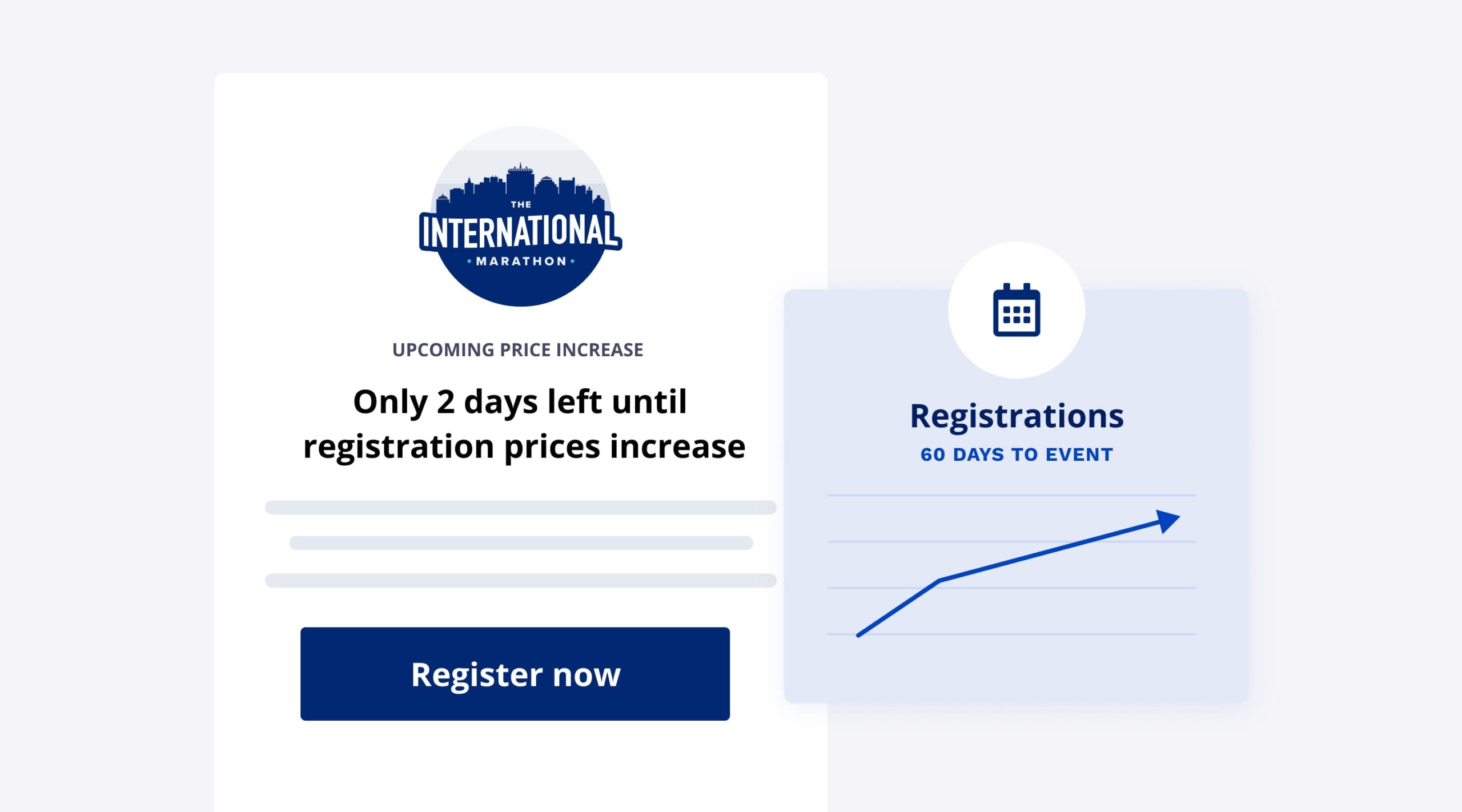Tips & Tricks | Estimated Read time – 8:02
Are you planning an endurance event and looking for effective ways to increase registration numbers within the last 30-60 days before the big day? Timing, price increases, and a well-executed marketing strategy can work wonders in creating a sense of urgency among potential participants, encouraging them to decide quickly.
This marketing tactic is often called the law of scarcity, and it influences a lot of our behavior. In fact, you’ve probably experienced its effects without even realizing it.
The law of scarcity is a powerful tool in modern marketing and sales campaigns. You may have come across it when booking a flight or hotel room. Have you ever noticed a timer or countdown indicating how many rooms are left or how long you have to checkout to secure a specific price? That’s the law of scarcity in action, subtly urging you to make a decision.
Imagine this scenario: You’re searching for flights, and you stumble upon an amazing deal. But there’s only one seat left on your preferred flight! Suddenly, that sense of urgency kicks in. You wouldn’t want to miss out on that great price or lose your chance to secure the last seat, right?
That’s exactly how the law of scarcity works, nudging you towards acting and seizing the opportunity before it slips away. It’s a clever technique used by marketers to create a sense of urgency.
In this article, we detail the importance of creating a sense of urgency through timing, price increases, and a well-executed marketing strategy. We’ll also tell you how you can use them to boost registration for your event.
The Power of Timing

Timing plays a crucial role in driving registration numbers for any event, and endurance events are no exception. As the event date approaches, the sense of urgency naturally increases. This is the ideal time to ramp up your marketing efforts, conveying the limited time left for participants to secure their spot.
Through analysis of thousands of races in the Race Roster database, we have identified key moments when scarcity is already top of mind and registration sees a spike. These built-in scarcity moments are the perfect opportunity to align your marketing to maximize registration.
Here’s a breakdown of what we discover from our analysis and what the results mean for you:
For shorter distances: Registration increases greatly in the last 60 days leading up to an event. In fact, as much as 70% of registration can come in the last 60 days for a 5K or 10K event.
What this means for you: As you enter the final phase of registration, you can emphasize the limited time for registration and the limited availability for your event to create a sense of urgency.
For longer distances: We see the opposite of what we see for shorter distances. The first phase of registration sees higher sign-up rates than the later phases. Approximately 60–70% of half-marathon and full-marathon registrations before the halfway mark of the registration period.
What this means for you: After the halfway point of registration, draw attention to your event’s limited availability to help you pull forward event sign-ups. The more registration you pull forward, the fewer slots left; the fewer slots left, the more scarce and urgent registration becomes for your potential participant.
Remember that training time also plays a part in the timing of registrations—and you can use that to your advantage!
Participants are more likely to sign up for a 5K or 10K closer to event day than a half marathon or full marathon, simply due to the time it takes to train compared to longer distances. Playing to the ebb and flow of the training cadence is a natural way to incorporate the concept of scarcity.

Did You Know?
The ASICS Runkeeper™ app training programs offer personalized training plans for all distances. This is a great way to provide value to your participant, keep your event top of mind, and plant the seed to turn training into registration.
Ideas to leverage a training program include sending a timely email that shares a Runkeeper 10K training program to your participants who ran the 5K last year, encouraging them to challenge themselves even further.
Or you can send an email that includes our 5K tune-up training program to participants who registered for last year’s event but haven’t registered yet this year (timed appropriately so participants are able to complete their training).

Finally, you can make the registration decision even easier by offering a purchase protection policy that will allow potential participants to receive a registration refund if they are unable to take part. The policy provides peace of mind and could be the final push potential participants need to register for your event. Here’s an easy-to-follow how-to article that explains how to set this feature up on our platform.
Price Increases

Timing and price increases are inherently linked when creating scarcity for an event. Predictably, registration sees significant spikes right before a price increase. Participants understand the limited-time nature of a deadline and will move to lock in their best price.
Don’t let any price increase go to waste! Leveraging price increases is a great way to ensure you’re maximizing registration, especially in our current economic climate where discretionary spending is tight.
Implementing a clearly communicated pricing strategy that involves gradual increases leading up to your event date can significantly drive registration. In the final 60 days before your event, advertising a price increase, progressively rising until the event date, will support a growing sense of urgency and motivate potential participants to act promptly.

At Race Roster, we offer a registration pricing option designed specifically for scarcity. Block Pricing consists of set prices that dynamically increase as a “block” of registration sells out. This feature allows you to tier pricing based on the number of people registered rather than a specific date and time. Price jumps happen automatically when predetermined thresholds are met, and the unpredictability of when a “good price” will run out will push participants to register early so they don’t miss out.
This is a great way to pull forward registration from keen and loyal participants and reward. As spaces run out and inventory gets tighter, it makes sense to charge a premium for late-comers.
Our block pricing setup is completely customizable and gives you the power to set exactly how many runners you’d like to accept into certain pricing blocks.
Want to learn more about pricing strategies?
For more in-depth reading on the various pricing strategies, see our guide on selecting a pricing strategy for your event. To implement one of these strategies, follow our how-to’s for scheduled pricing and block pricing.
Crafting an Effective Marketing Strategy

A well-crafted marketing strategy is the backbone of driving registration numbers. Now that we’ve outlined the key times when the law of scarcity is the most present, here are key marketing tactics to consider in the final 30–60 days that create a sense of urgency to increase your event registration:
1. Selling The Full Experience: Craft persuasive messages that highlight the unique aspects of your endurance event, like beautiful scenery, challenging routes, or exclusive event-day perks. Selling the full experience to your participants will drive interest and support the value of your event. Emphasize the limited time left and the need to register before it’s too late.
2. Utilize Social Media: Leverage the power of social media platforms to create a sense of excitement and urgency. Share engaging posts, countdowns, and teaser videos to build anticipation. Consider partnering with influencers or running communities to amplify your reach.
3. Email Marketing: Increase your email cadence. If you regularly send one email per month, send up to three emails per week during the final push for registration. You can include testimonials from previous participants, success stories, and other valuable content to reinforce the value of your event. Check out our article on best event email marketing practices to help you drive up even more registrations in the final weeks leading up to your event.
4. Limited-Time Offers: Introduce limited-time promotions, such as discounted group registrations, exclusive merchandise, or early access to race-day information. These incentives can create a fear of missing out (FOMO) and drive last-minute sign-ups.
Other industries do a great job utilizing this tactic. Fashion brands, for instance, use exclusive product drops when releasing limited edition products for a short period of time. In order to gain access to these products, you register for waitlist access and gain pre-product drop information about the product itself.
For endurance events, a limited edition medal for the first 100 participants is a great way to set your registration up for success. During slower registration months, releasing limited edition t-shirt designs can also bolster registration sales.
5. Digital Marketing Efforts: If you are running a search campaign to support your event registration, update your headlines to incorporate a sense of urgency. Online efforts are a great way to get your message in front of your audience, and Google even offers a way to incorporate a countdown timer directly into your ads to support your campaign success.
Creating a sense of urgency within the final 30–60 days before your endurance event is crucial for boosting registration numbers. By strategically leveraging timing, price increases, and an effective marketing strategy, you can effectively motivate potential participants to take action.
Remember to communicate the limited time left, emphasize price increases, and use engaging messaging across various platforms to maximize your reach. With a well-executed plan, you can ensure a successful and highly attended event that leaves participants eagerly anticipating future editions.

What’s new at Race Roster?
Visit our what’s new page for the most noteworthy Race Roster updates!